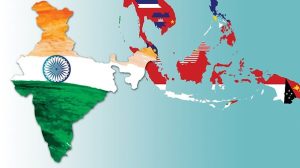19 Nov Soft Loans by India
Act East Policy
This article is based on the “Act East Policy“. It talks about India and its neighborhood- relations significance of Soft Loans by India
Relevance for Prelims: Terminology, Statistics vis-à-vis Soft Loans, Act East Policy
Relevance for Mains: Significance of the act, Neighbor relations of India
Context: Foreign Secretary of India and G-2- chief coordinator said the volume of India’s soft loans to neighboring countries has increased from $3 billion to almost $15 billion in the last eight years.
About Soft Loans:
- A soft loan is a loan with no interest or a below-market rate of interest, Also known as “soft financing” or “concessional funding,” soft loans have lenient terms, such as extended grace periods in which only interest or service charges are due, and interest holidays. They typically offer longer amortization schedules (in some cases up to 50 years) than conventional bank loans.
- Soft loans are often made by multinational development banks (such as the Asian Development Fund), affiliates of the World Bank, or federal governments (or government agencies) to developing countries that would be unable to borrow at the market rate.
Significance of Act East policy
1. Promote economic cooperation: The foremost objective of Act East Policy is to integrate economies of South-East Asian regions through continuous engagement at regional, bilateral and multilateral levels.
2. Alternative Traditional partners: More focus on the neighbour economies will make South-Asia region more integrated.
3. North-East Development: Integration with South-east Asian and East-Asian economies will aid in development of North-East states.
4. Security Engagement: India’s defence cooperation with South-Asian economies have increased. For example: In 2014, India and Vietnam signed a MoU (Memorandum of Understanding) to open a line of credit for purchase of defense equipment.

Pic: India and its neighborhood
Concerns:
1. Chinese Dragon influence: Growing Chinese influence with increasing hostilities with India on border areas is a major roadblock to the development of the ASEAN region.
2. There is a scarcity of economic agreements signed between India and South-East Asian economies. So far, India has signed a few agreements on reaping Blue Economy.
3. Civil Society’s attitude is impacted by India’s majoritarianism attitude over one religion.
4. Protectionist policies have increased which has hindered the integration of economies.
There must be empowering of states by the government to play a better role under the Act. For example, Northeast states could be used to bridge the gaps between the Centre and States while implementing Act East.
Neighboring countries such as Bangladesh and Sri Lanka should also be added which would ensure better development of India’s eastern and north-eastern states.
Best Daily Current Affairs for UPSC
Current Affair is very crucial for passing the IAS exam. Everybody should be habituated to reading Daily Current Affairs for the UPSC examination. Plutus IAS provides you with the Best Daily Current Affairs for UPSC free of cost. So visit our Daily Current Affairs Site and read daily moderated current affairs every day.
Source:



No Comments